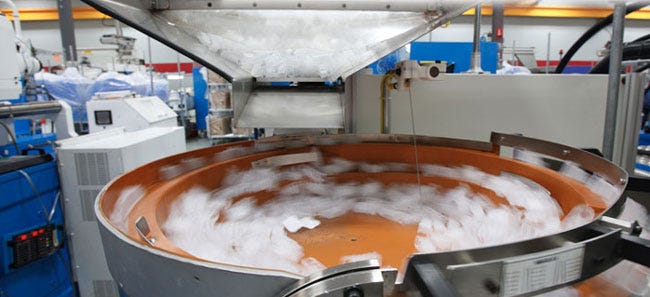4 Things You Need to Know about MedTech Suppliers
April 29, 2014
|
Shore, director of quality at Nypro, spoke on supplier controls at MD&M Texas on Wednesday, May 7. |
Jim Shore knows more than a thing or two about enhancing relationships between medical device OEMs and suppliers. A few years back, he was part of a program at Boston Scientific that reduced field actions among its contract manufacturers from 11 down to three--leading to about $8 million in savings.
Shore, who is now director of quality at Nypro (Clinton, MA), says the strategy was to reduce field actions by scrutinizing the big suppliers that contributed to the regulatory problems.
"We looked at the criticality of the devices that they were involved in, and sent out teams to go look at what controls they had, what the communication tool was for making changes, and for notifying us," Shore says.
Shore's group put together process control plans to better understanding the inputs and outputs in the suppliers' manufacturing processes.
"We eliminated a lot of failures from occurring because we would know ahead of time when problems cropped up," Shore says. If changes had to be made, the group worked to rationalize them to make sure they didn't impact the product quality.
Shore spoke about proactive supplier controls at MD&M Texas on Wednesday, May 7, explaining both the point of view of the OEM and the contract manufacturer. He'll discuss the importance of guidance based on industry standards.
Here are four things he's learned over the years when it comes to maintaining relationships between medtech OEMs and suppliers:
|
When working with a contract manufacture, the importance of having clear and regular communication cannot be overstated. Shown here is the high speed assembly equipment from Nypro. |
1. What Is Good One Place Isn't Good Everywhere
Shore shares the example of how a quality engineer at a device company might see one supplier do something a certain way, and decide that everybody else should do it the same way.
"But that approach might not be the best for every case. And by enforcing that as the requirement, you are going to drive cost that might not add any value and may not add value to the product," Shore says.
"As far as supplier quality is concerned, you can have some guidelines and some guidance, but you need to modify it and make it flexible based on the situation. And that's normally not done very well."
2. Listen to the Experts
"What medical device OEMs can do is understand and listen to the process experts [from the contract manufacturer]," Shore says. "Sometimes, people insist they know what is going on when they don't really, and then they don't listen to the subject matter experts."
Hear several field experts from Nypro Healthcare deliver deliver a free hour-long classroom presentation on shortening product development cycles with the right cross functional teams on Tuesday, June 10th, 2014 at MD&M East in New York. |
3. Keep Communication Lines Open (Or Your Tools Will End Up in a Barn)
While the relationship between device companies and manufacturing partners is critical, such partnerships can be difficult to maintain--especially when the partners are located thousands of miles apart. Shore shares the story of a company that initially stayed in regular contact with a contract manufacturer in China. After a while, however, the communication slowed down, which led the outsourcing firm to tell the OEM: "You need to come here and pick up your tools because we've stopped manufacturing for you. We don't feel that you care enough about us, so you need to take your tools away."
To retrieve its tools, the device firm had to sent representatives on something of a wild goose chase. The firm had to "go quite a distance to find them, and they were stuck in a barn," Shore says.
When working with a partner abroad, it can make sense to hire people based in the area to help make sure everything is running smoothly. "But you have to have trust in them too," Shore says.
4. Inspire by Sharing Information
Medical device makers that are outsourcing the production of components to a partner should consider sharing information on the finished medical device with the partner. "A lot of contract manufactures don't really know what they are making. They see a widget. They see a piece of the pie," Shore says. "A lot of times, I bring finished medical devices to these contract manufacturers and provide them with some marketing information and show them how the product is used."
"We did this once, and a woman working on a component for a surgical mesh implant discovered that she had the finished device implanted," Shore says.
When people working on a product understand what they are helping make, "they understand why it is so important, and now they have ownership because they know that that device is going to be used to save somebody's life."
Brian Buntz is the editor-in-chief of MPMN. Follow him on Twitter at @brian_buntz and Google+.
About the Author(s)
You May Also Like



.png?width=300&auto=webp&quality=80&disable=upscale)
